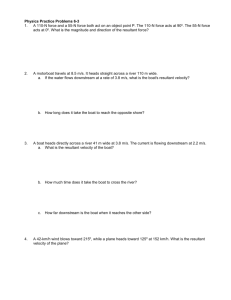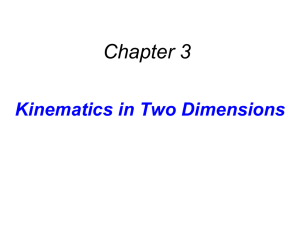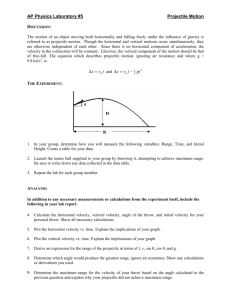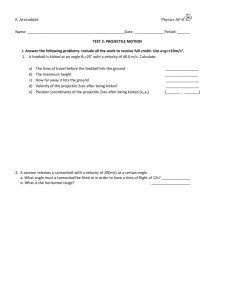Chapter 5 Projectile motion
advertisement
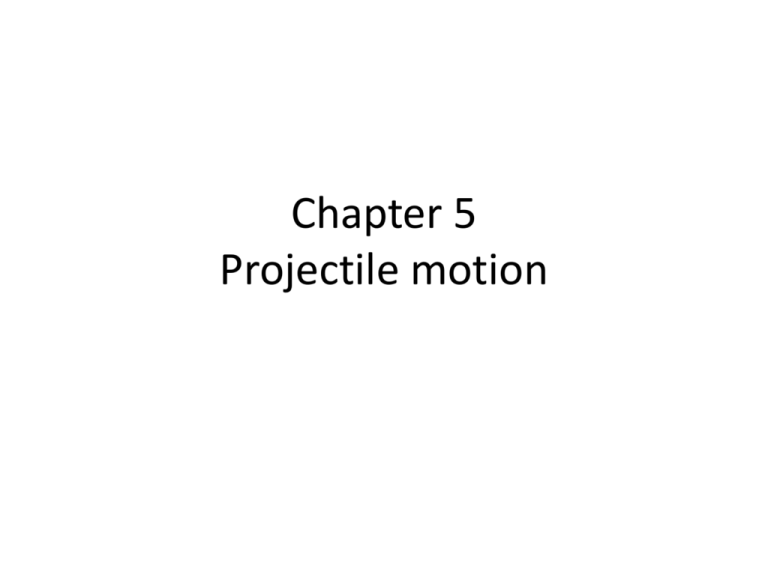
Chapter 5 Projectile motion Chapter 4: straight line motion that was ONLY vertical or ONLY horizontal motion Chapter 5: considers motion that follows a diagonal path or a curved path When you throw a baseball, the trajectory is a curved path. We are going to separate the motion of a projectile into independent x and y motions The vertical motion is not affected by the horizontal motion. And the horizontal motion is not affected by the vertical motion. Observe: a large ball bearing is dropped at the same time as a second ball bearing is fired horizontally. What happened? Remember adding 2 perpendicular vectors horizontal and vertical vectors. When we add perpendicular vectors we use Pythagorean theorem to find the resultant. Consider a vector B that is pointed at an angle q wrt horizontal direction. We are going to break vector B into 2 perpendicular vectors: Bx and By if you ADD vectors Bx + By you get vector B. Graphically, we can say: Draw a rectangle with vector B as the diagonal. the component vectors Bx and By are the sides of the rectangle Application: A Boat in a river How can we describe the motion of a boat in a river? The motion is affected by the motor of the boat and by the current of the river Imagine a river 120 meters wide with a current of 8 m/sec. Imagine a river 120 meters wide with a current of 8 m/sec. If a boat is placed in the river [motor is off] , how fast will the boat drift downstream? If the boat is drifting, the total speed of the boat just equals the speed of the current. for a boat drifting with the current: Vtotal = Vboat + Vcurrent Vtotal = -0 + Vcurrent = 8 m/sec Now suppose this boat can travel at a constant 15 m/sec when the motor is on . What is the total speed of the boat downstream when the motor is on? The boat is traveling in the same direction as the current. V total downstream = Vtotal = Vboat + Vcurrent Vtotal = 15↓ + 8↓ = 23 m/sec ↓ What is the total speed of the boat traveling upstream [against the current] ? The boat and current now move in opposite directions Vtotal = Vboat +Vcurrent Vtotal = 15 ↓+ ( 8 ↑) Vtotal = 7↓ m/sec Summary: traveling downstream: Vboat + Vcurrent Traveling upstream: Vboat + [-Vcurrent] Crossing the river. If there was no current, how many seconds needed for this boat to travel 120 meters from A to B? Velocity = distance time so time = distance velocity time = distance velocity time = 120 m 15 m/sec time = 8 seconds But there if IS a current. what happens when you try to go straight across the river from A to B? The boat will travel from A to C. Every second the boat travels ACROSS 15 meters and AT THE SAME TIME every second the boat will be pushed DOWNSTREAm 8 meters by the current . Vboat = 15 and Vcurrent = 8↓ These velocities are perpendicular The RESULTANT velocity of the boat is Vresultant2 = Vboat2 + Vcurrent2 Vresultant2 = 152 + 82 Vresultant2 = 225+ 64 =289 Vresultant = 17 m/sec The boat still crosses the river in 8 seconds , but it lands downstream at point C not at point B. How far downstream is point C? Since the boat travels for 8 seconds the current pushes the boat for 8 seconds Vcurrent = 8 m/sec Velocity = distance/time so Distance = Velocity• time Distance = 8 m/sec • 8 sec distance downstream = 64 meters What is the total distance the boat travels? D2 = Dx2 + Dy2 D2 = 1202 + 642 D2 = 14400+4096 D2 = 18496 D = 136 meters The triangles are similar: REMEMBER Every second the boat travels 15 meter across in the x direction IT ALSO TRAVELS 8 meter in the y direction What if you want to travel from point A to point B? Can you do that? You can cross from A to B if you point the boat in the correct direction. Remember: Two perpendicular vectors can be added to produce a single resultant vector that is pointed in a specific direction. SIMILARLY ANY vector at angle q can be broken into the sum of two perpendicular vectors: one vector only in x direction and one vector only in y direction. The magnitude of the component vectors is given by Vx = Vocosq Vy = Vosinq If you want to travel from A to B, you must direct the boat so that the “y component” of the boat’s velocity cancels the velocity of the current. Point the boat so that the component of the boat’s velocity “cancels” the river Choose VboatY so that it is equal and opposite to the Vcurrent VboatX = Vboatcosq VboatY = Vboatsinq How do we find angle q, the direction to point the boat? Use arcsin or arctan arcsin = sin-1 Arcsine means “ the angle whose sine is” : Sin-1 [VboatY/Vboat] = q Arctan = Tan-1 Arctan means “ the angle whose tangent is” Arctan = Tan-1 Arctan means “ the angle whose tangent is” tan-1[Vboaty/Vboatx] = q Remember PROJECTILE MOTION Projectile motion: A projectile that has horizontal motion has a parabolic trajectory We can separate the trajectory into x motion and y motion. In the x direction: constant velocity Vx = constant distance in x direction X = Vx • t In y direction: free fall = constant acceleration. Velocity in y direction : V = Vo – g t Distance in y direction Y = Yo + Vot – ½ g t2 The range of a projectile is the maximum horizontal distance. Range and maximum height depend on the initial elevation angle. If you throw a projectile straight up, the range = 0 height is maximum. 0 degrees : the minimum range but the maximum height. The maximum range occurs at elevation 45o And for complementary angles 40 and 50 degrees 30 and 60 degrees 15 and 75 degrees 10 and 80 degrees The range is identical for complementary angles BUT the larger elevation angle gives a greater maximum height. Remember: For a horizontal launch: Vo = initial horizontal velocity 0 = initial vertical velocity in x direction: velocity is constant in y direction: acceleration is constant If one object is fired horizontally at the same time as a second object is dropped from the same height, which one hits the ground first? Horizontal launch: in x [horizontal] direction velocity is constant Vx = Vo acceleration = 0 range = Vo • t [t = total time ] Horizontal launch: In y direction: projectile is free falling. Voy = 0 Acceleration = g = 10 m/sec2↓ V = gt ↓ d = ½ gt2 Projectile motion lab: part 1 Part 1: determine the velocity Vo of the projectile. Projectile: - fired horizontally from height h. - follows parabolic path - Range R is where projectile hits the floor. Equations: in y direction Voy = 0 g = constant acceleration distance h = ½ 2 gt Equations in x-direction acceleration = 0 [constant velocity] V= Vo Range R = Vo ▪ t Part 1: fire projectile horizontally. Measure all distances in METERS. Measure starting height , h. Measure range R. Part I Calculations: distance h = ½ gt2 measure h [ in METERS] use g = 10 m/sec2 solve equation to find t [ in seconds ] distance h = ½ gt2 h= 5 t 2 Measure value for R, the range in x direction in METERS Use equation: R = Vo ∙ t use measured value of R and calculated value for T Example: A projectile is fired horizontally from a table that is 2.0 meters tall. The projectile strikes the ground 3.6 meters from the edge of the table. Given: H = 2.0 meters R = 3.6 meters h = ½ g t2 R = Vo t h = ½ g t2 2.0 = ½ [10] t2 2 t 2.0 = ½ [10] 2.0 = 5 t2 2/5 = 0.40 = t2 t = 0.63 sec For equation: R = Vo t use R = 3.6 m and t = 0.63 sec R = 3.6 m = Vo [.63 sec] Vo = 3.6 m 0.63 sec Vo = 5.7 m/sec The height of a projectile at any time along the path can be calculated. First calculate the height if there was no gravity. If that case, a projectile would follow a straight line path the projectile is always a distance 5t2 below this line. Y = voy t – ½ gt2 Y = voy t – 5t2 i summary Vectors have magnitude and direction Scalars have only magnitude The resultant of 2 perpendicular vectors is the diagonal of a rectangle that has the 2 vectors as the sides. The perpendicular components of a vector are independent of each other. The motion of a boat in a stream is the sum of a constant velocity of a boat [x dir] and the constant velocity of the stream [y dir] The path of a boat crossing a stream is diagonal The horizontal component of a projectile is constant, like a ball rolling on a surface with zero friction. Objects in motion remain in motion at constant speed. The vertical component of a projectile is same as for an object in free fall. The vertical motion of a horizontally fired projectile is the same as free fall. For a projectile fired at an angle, the projectile will be 5t2 below where it would be if there was no gravity.



